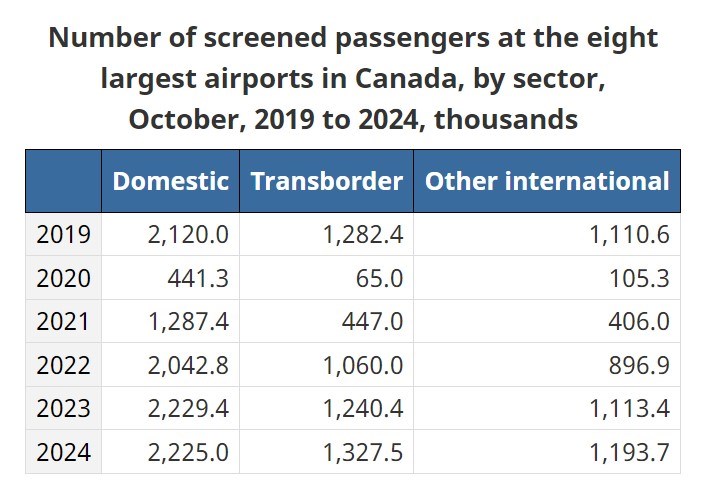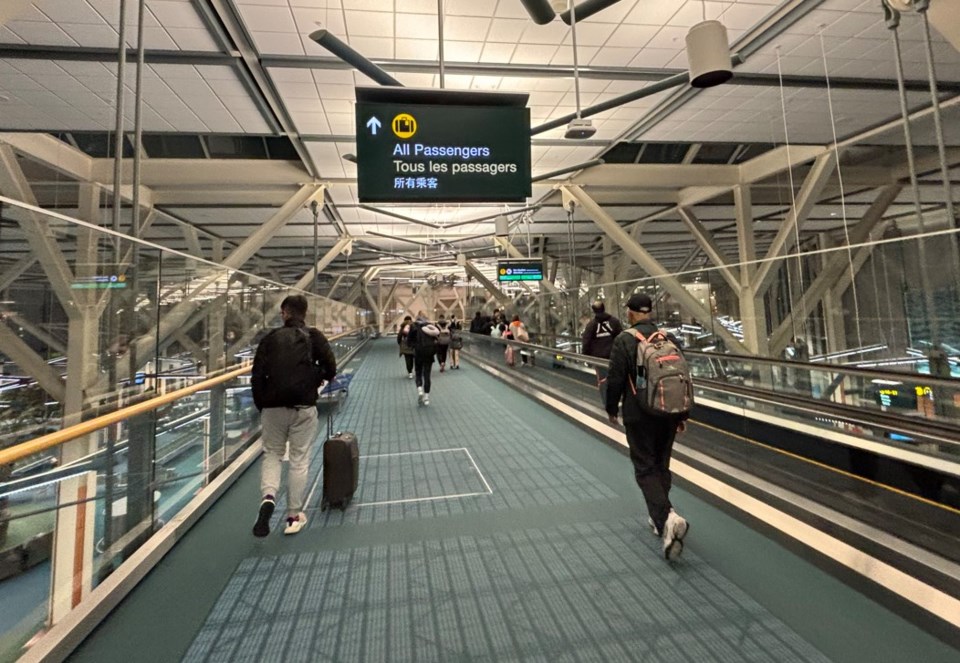Various data is pointing to traveller volumes in Canada being up year-over-year.
It would be a stretch to call this a boom, however. And there are instances where data seem to conflict, or point in different directions depending on whether it is for international visitors who enter the country through B.C entry points or for those who use the country's largest eight airports.
Statistics Canada released data yesterday that tallied all screened passengers at the largest eight airports in the country in October. It calculated 4.7 million screened passengers, which was higher than the 4.6 million screened passengers in October 2023 and the 4.5 million screened passengers in October 2019.
The nation's number cruncher then broke down those screened passengers' flights into ones that flew domestically, ones that were across the U.S. border (transborder) and ones that were otherwise international. In each of those cases, there were more travellers in October than in October 2019, before the COVID-19 pandemic took hold in 2020. There were slightly more domestic travellers at those airports in 2023 than in 2024, however.

Other data, which focuses on international visitors to Canada through B.C. entry points, continues to show that travel is down compared with 2019.
Destination British Columbia released data this month for September showing that 493,230 international visitors entered Canada via B.C. entry points and stayed at least one night. That was up 0.4 per cent, compared with September 2023 but is down 24.7 per cent compared with September 2019, according to the province's destination marketer, which crunches numbers provided by Statistics Canada.
In the first nine months of this year, the number of foreign visitors entering Canada through B.C. entry points and staying at least one night was 4,342,759, according to Destination BC. That is up 7.4 per cent compared with the same time period in 2023 but down 19.3 per cent compared with the same time period in 2019.
Overnight visits by citizens of many nations to Canada through B.C. in the first nine months of this year remain far below where they were in 2019. Countries with the biggest drops in that time frame in sending those visitors include China (down 55.4 per cent), Japan (down 40.2 per cent), South Korea (down 33.9 per cent) and France (down 32.4 per cent).
The number of Asian nationals visiting Canada through B.C. entry points has started to normalize. And Air Canada's plan to more than triple the number of flights it flies non-stop between Vancouver and mainland China bodes well for that trend continuing.
Separate new data focuses on Canadians' travel
Other Statistics Canada data released yesterday provided an in-depth look at Canadians' travel in the three months that ended in June.
Canadians, it said, took a total of 79.2 million trips in the year's second quarter. That was up 1.2 per cent from the same quarter of 2023 and an increase of three per cent from the same period in 2019. Most of the trips in the second quarter were domestic (88.3 per cent), followed by trips to the U.S. (8.2 per cent).
Inflation means travellers are spending more
Statistics Canada estimated that in the April-through-June period, Canadian residents spent $17.9 billion on domestic travel, up 1.1 per cent from the second quarter of 2023 and a staggering increase of 30.5 per cent from the same quarter of 2019.
In the second quarter of 2024, the average amount spent per domestic trip was $255 ($123 for same-day trips and $493 for overnight trips), with an average trip length of one night. The top three spending categories were accommodations, vehicle operations, and restaurants and bars.
Visitors' spending was also up.
In the April-through-June period, visitors to Canada from other countries made 8.2 million trips. That is up 11 per cent from the same quarter in 2023. About 78.4 per cent of those trips were made by U.S. residents.
Meanwhile, spending by non-resident visitors to Canada totalled $7.4 billion in the second quarter, Statistics Canada said. That is an increase of 5.2 per cent from the second quarter of 2023. The average amount spent per trip in the quarter was $897.
Higher travel volumes have airlines adopting new technology
Air Canada yesterday announced its plan to start screening passengers at gates using facial-recognition technology, starting at Vancouver International Airport (YVR).
No other airline has yet done this in Canada.
Starting Tuesday (Dec. 2), customers who board most domestic Air Canada flights at YVR will be able to walk onto planes without presenting physical identification, such as passports or driver's licences, according to the airline. Those passengers would show their faces to screening technology that would verify their identities. The new program is optional and passengers will be allowed to continue to simply show their passports.
The key to the technology is the Air Canada app.
Those who use the program would upload photos of their faces and scans of their passports to that app. This way the airline will be able to verify that a person with unique facial characteristics is connected to a specific passport. Air Canada said that for privacy reasons, the data in traveller profiles is encrypted and deleted 36 hours after departure.
Delta Air Lines started using facial-recognition technology in 2021 at the Atlanta and Detroit airports.
Germany's Frankfurt Airport last year began to allow all airlines to use facial biometrics at check-in kiosks and at boarding gates, after first allowing some use in 2020.



